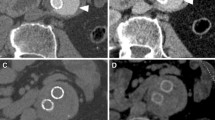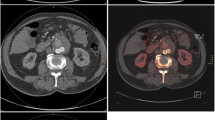Abstract
Purpose
An ultra-low-dose radiation protocol reconstructed with model-based iterative reconstruction was compared with our standard-dose protocol.
Methods
This prospective study evaluated 20 men undergoing surveillance-enhanced computed tomography after endovascular aneurysm repair. All patients underwent standard-dose and ultra-low-dose venous phase imaging; images were compared after reconstruction with filtered back projection, adaptive statistical iterative reconstruction, and model-based iterative reconstruction. Objective measures of aortic contrast attenuation and image noise were averaged. Images were subjectively assessed (1 = worst, 5 = best) for diagnostic confidence, image noise, and vessel sharpness. Aneurysm sac diameter and endoleak detection were compared.
Results
Quantitative image noise was 26% less with ultra-low-dose model-based iterative reconstruction than with standard-dose adaptive statistical iterative reconstruction and 58% less than with ultra-low-dose adaptive statistical iterative reconstruction. Average subjective noise scores were not different between ultra-low-dose model-based iterative reconstruction and standard-dose adaptive statistical iterative reconstruction (3.8 vs. 4.0, P = .25). Subjective scores for diagnostic confidence were better with standard-dose adaptive statistical iterative reconstruction than with ultra-low-dose model-based iterative reconstruction (4.4 vs. 4.0, P = .002). Vessel sharpness was decreased with ultra-low-dose model-based iterative reconstruction compared with standard-dose adaptive statistical iterative reconstruction (3.3 vs. 4.1, P < .0001). Ultra-low-dose model-based iterative reconstruction and standard-dose adaptive statistical iterative reconstruction aneurysm sac diameters were not significantly different (4.9 vs. 4.9 cm); concordance for the presence of endoleak was 100% (P < .001).
Conclusion
Compared with a standard-dose technique, an ultra-low-dose model-based iterative reconstruction protocol provides comparable image quality and diagnostic assessment at a 73% lower radiation dose.


Similar content being viewed by others
Abbreviations
- ASIR:
-
Adaptive statistical iterative reconstruction
- CNR:
-
Contrast to noise ratio
- CT:
-
Computed tomography
- CTDIvol :
-
Volume computed tomographic dose index
- DLP:
-
Dose-length product
- EVAR:
-
Endovascular aneurysm repair
- FBP:
-
Filtered back projection
- MBIR:
-
Model-based iterative reconstruction
- MRI:
-
Magnetic resonance imaging
- SAFIRE:
-
Sinogram affirmed iterative reconstruction
- SOC:
-
Standard of care
- ULD:
-
Ultra-low-dose
References
Brenner DJ, Hall EJ (2007) Computed tomography: an increasing source of radiation exposure. N Engl J Med 357(22):2277–2284
Hall EJ, Brenner DJ (2008) Cancer risks from diagnostic radiology. Br J Radiol 81(965):362–378
Pearce MS, Salotti JA, Little MP, et al. (2012) Radiation exposure from CT scans in childhood and subsequent risk of leukaemia and brain tumours: a retrospective cohort study. Lancet 380(9840):499–505
Chaikof EL, Brewster DC, Dalman RL, et al. (2009) Society for vascular surgery. The care of patients with an abdominal aortic aneurysm: the Society for Vascular Surgery practice guidelines. J Vasc Surg 50(4 Suppl):S2–49
Stavropoulos SW, Charagundla SR (2007) Imaging techniques for detection and management of endoleaks after endovascular aortic aneurysm repair. Radiology 243(3):641–655
Sagara Y, Hara AK, Pavlicek W, et al. (2010) Comparison of low-dose CT with adaptive statistical iterative reconstruction and routine-dose CT with filtered back projection in 53 patients. AJR Am J Roentgenol 195(3):713–719
Hara AK, Paden RG, Silva AC, et al. (2009) Iterative reconstruction technique for reducing body radiation dose at CT: feasibility study. AJR Am J Roentgenol 193(3):764–71. Erratum in: AJR Am J Roentgenol 2009;193(4):1190
Thibault JB, Sauer KD, Bouman CA, Hsieh J (2007) A three-dimensional statistical approach to improved image quality for multislice helical CT. Med Phys 34(11):4526–4544
Vardhanabhuti V, Loader R, Roobottom CA (2013) Assessment of image quality on effects of varying tube voltage and automatic tube current modulation with hybrid and pure iterative reconstruction techniques in abdominal/pelvic CT: a phantom study. Invest Radiol 48(3):167–174
Deak Z, Grimm JM, Treitl M, et al. (2013) Filtered back projection, adaptive statistical iterative reconstruction, and a model-based iterative reconstruction in abdominal CT: an experimental clinical study. Radiology 266(1):197–206
Singh S, Kalra MK, Do S, et al. (2012) Comparison of hybrid and pure iterative reconstruction techniques with conventional filtered back projection: dose reduction potential in the abdomen. J Comput Assist Tomogr 36(3):347–53. Erratum in: J Comput Assist Tomogr 2012;36(5):627
Husarik DB, Marin D, Samei E, et al. (2012) Radiation dose reduction in abdominal computed tomography during the late hepatic arterial phase using a model-based iterative reconstruction algorithm: how low can we go? Invest Radiol 47(8):468–474
Macari M, Chandarana H, Schmidt B, et al. (2006) Abdominal aortic aneurysm: can the arterial phase at CT evaluation after endovascular repair be eliminated to reduce radiation dose? Radiology 241(3):908–914
Bley TA, Chase PJ, Reeder SB, et al. (2009) Endovascular abdominal aortic aneurysm repair: nonenhanced volumetric CT for follow-up. Radiology 253(1):253–262
Stolzmann P, Frauenfelder T, Pfammatter T, et al. (2008) Endoleaks after endovascular abdominal aortic aneurysm repair: detection with dual-energy dual-source CT. Radiology 249(2):682–691
Numburi UD, Schoenhagen P, Flamm SD, et al. (2010) Feasibility of dual-energy CT in the arterial phase: imaging after endovascular aortic repair. AJR Am J Roentgenol 195(2):486–493
Winklehner A, Karlo C, Puippe G, et al. (2011) Raw data-based iterative reconstruction in body CTA: evaluation of radiation dose saving potential. Eur Radiol 21(12):2521–2526
Machida H, Tanaka I, Fukui R, et al. (2013) Improved delineation of the anterior spinal artery with model-based iterative reconstruction in CT angiography: a clinical pilot study. AJR Am J Roentgenol 200(2):442–446
Suzuki S, Machida H, Tanaka I, Ueno E (2013) Vascular diameter measurement in CT angiography: comparison of model-based iterative reconstruction and standard filtered back projection algorithms in vitro. AJR Am J Roentgenol 200(3):652–657
Pickhardt PJ, Lubner MG, Kim DH, et al. (2012) Abdominal CT with model-based iterative reconstruction (MBIR): initial results of a prospective trial comparing ultralow-dose with standard-dose imaging. AJR Am J Roentgenol 199(6):1266–1274
Acknowledgments
This research was supported by a research agreement with GE Healthcare, Milwaukee, Wisconsin.
Ethical Standards
The study received institutional review board approval, ensuring that the study met federal and state regulations, institutional policies on the ethical conduct of research, and the ethical standards in the 1964 Declaration of Helsinki. Written informed consent was obtained from all patients.
Conflict of interest
None.
Author information
Authors and Affiliations
Corresponding author
Rights and permissions
About this article
Cite this article
Naidu, S.G., Kriegshauser, J.S., Paden, R.G. et al. Ultra-low-dose computed tomographic angiography with model-based iterative reconstruction compared with standard-dose imaging after endovascular aneurysm repair: a prospective pilot study. Abdom Imaging 39, 1297–1303 (2014). https://doi.org/10.1007/s00261-014-0166-1
Published:
Issue Date:
DOI: https://doi.org/10.1007/s00261-014-0166-1




